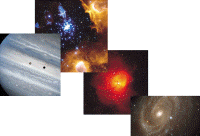The Heritage from Hubble
- Ground-based and space-based astronomy
- Experiences from Hubble
- Comparisons of Hubble and NGST
- HUBBLE
- NGST
 Ground-based and space-based astronomy
Ground-based and space-based astronomy
Hubble has been very successful as the first large-scale space-based observatory. Compared to the many 8-10 metre telescopes which already exist or are being built today, Hubble is certainly not very large - its light-collecting surface is almost 20 times smaller than the largest telescopes on Earth.
However, one of the biggest challenges to ground-based astronomy is the degradation of images by the Earth's atmosphere, whereas space-based observatories enjoy the perfect clarity of space.
Figure 1. Images from Hubble
Space observatories like Hubble and NGST work closely together with their ground-based counterparts in an extremely fruitful collaboration. The big telescopes can gather more light in a shorter time, which is essential for applications such as spectroscopy where the composition of stars, galaxies and other objects are investigated. Space-based observatories allow a closer look at the structure of objects, and big ground-based telescopes deliver the key to their composition. Together the two types of telescopes are highly productive and complementary, enabling astronomers to determine the true nature of the observed objects.
 Experiences from Hubble
Experiences from Hubble
NGST will benefit from experience gained with Hubble - both in terms of the operation of a large space-based observatory and the science it can carry out. Although NGST will mainly be sensitive to wavelengths beyond the reach of Hubble and groundbased telescopes, NGST's main scientific areas will largely be the logical extension of areas where Hubble already has proved successful.
Hubble's deep imaging has lifted a corner of the veil hiding the remote parts of the Universe. NGST will continue the scientific strategies of Hubble and continue to expand our horizons in terms of distance and time.
 Comparisons of Hubble and NGST
Comparisons of Hubble and NGST
Figure 2. Hubble and NGST compared in size and weight
Diameter of main mirror |
2.4 m |
8 m |
Location |
Low Earth orbit (600 km) |
Far from Earth in L2 (1.5 million km) |
Launch |
Space Shuttle |
Unmanned launcher |
Weight |
11 tonnes |
3 tonnes |
Lifetime |
20 years |
5-10 years |
Servicing missions |
5-6 planned |
No |
Operating temperature |
20°C |
-240°C |
Mirror |
Rigid, heavy, ceramic |
Deployable, thin, active, light |
Wavelength range |
0.1 - 2.5 microns (100 - 2 500 nm) |
0.6 - 28 microns (600 - 28 000 nm) |
Resolution |
0.05 arcseconds (at 500 nm) |
0.05 arcseconds (at 2 microns) |


